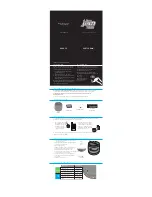
www.harbingerproaudio.com
7
allow the Full-range loudspeakers to provide improved clarity in
the mid and high-range frequencies.
DO NOT engage the LOW-CUT switch on HP112, HP115, or
HP215 Full-range loudspeakers when connected to HP outputs of
HP118S subwoofer. The Input signal for your full-range loudspeaker
has already been processed by HP118S’s circuitry.
HP112: We recommend switching the filter ON for the best sound
clarity. If using as a floor monitor, turn the filter ON for improved
vocal range clarity and to reduce low frequency build-up
on stage.
7
OUTPUT CONNECTIONS
All Full-range models have one XLR output connector marked
OUTPUT. The output connector is wired in parallel with the input,
allowing connection of multiple enclosures in a “daisy-chain”
fashion. The HP118Shas two sets of output connectors, one set
(left and right) for full-range outputs (wired in parallel with inputs)
and one set (left and right) for high-pass outputs.
HP112, HP115, HP215: Insert the XLR connector into the jack
marked OUTPUT. Connect the other end of the cable to the input
of the next down-stream audio device, such as another HP Series
range loudspeaker.
HP118S OUTPUT (Full-range): Use the outputs marked OUTPUT
(Full-range) (left and/or Right) when you are connecting to other
speakers and/or to other powered loudspeakers that enable full-
range audio or if they feature their own low frequency filtering.
HP118S HP (High-pass) OUTPUTS: Use the outputs marked HP
OUTPUT (Left and/or Right) when you are connecting other HP
Series and/or other powered loudspeakers that DO NOT feature
low frequency filtering or when the low frequency roll off is
desired. DO NOT use the HP OUTPUT connectors for connecting
other powered subwoofer loudspeakers - use the OUTPUT (Full-
range) line outs instead.
NOTE: Make sure to power OFF any HP Series and/or other
powered loudspeakers connected to the HP OUTPUT before
turning off the HP118S subwoofer power. This will prevent any
unwanted transients (thuds, low-pops) from coming out of the
connected loudspeakers.
NOTE: When you connect the HP Series Full-range active
loudspeaker to HP outputs of the HP118S subwoofer, DO NOT
engage the LOW-CUT switch on Full-range loudspeaker. The input
signal has already been processed by HP118S’s circuitry.
Also, if you’re using full range loudspeakers from another
manufacturer, we recommend that they be connected to the
HP OUTPUT. This will ensure proper phasing of the full range
loudspeaker with respect to the HP118S subwoofer.
8
INPUT CONNECTIONS
All Full-range models have one female XLR line-level input
marked INPUT.
The HP118S has a second connector (two input connectors
total), one for the left channel’s audio input and one for the right
channel’s audio input.
Balanced connections should be used as much as possible to
reduce AC hum and interference, especially with long runs of
cable. On all HP amplifier modules, the input impedance is 20k
Ohm for balanced connections.
HP112, HP115, HP215: Insert the male XLR connector into the jack
marked INPUT. Ensure the connector is fully seated.
HP118S: FOR STEREO OPERATION WITH FULL-RANGE
CABINETS: From your mixer, insert the left channel’s XLR
connector into the left channel’s (L) INPUT connector. Connect
the right channel of your mixer by inserting the XLR connector into
the right channel’s (R) INPUT connector on the amplifier. When a
single input signal is used, (for mono operation) make certain the
input and output connections correspond to the same channel (L
or R). When two input signals are supplied to the amplifier, the
subwoofer’s gain is automatically increased by 6dB.
9
POLARITY SWITCH
HP118S: The HP118S has a POLARITY switch. When the POLARITY
switch is set to NORM, the polarity is such that a positive input
will cause the cone to push outward. When set to REV, the input
signal’s polarity is reversed and a positive going input will cause
the loudspeaker’s cone to pull inward.
When all of the loudspeakers in a system are operating with the
same polarity, a positive polarity signal causes the excursion (the
forward motion) of all loudspeaker cones. In turn, this sets up
a positive reinforcement of the sound wave (each loudspeaker
reinforces the output of the other loudspeakers). This effect refers
to the speakers being “in phase” The effect of proper “phasing” is
most noticeable in low (bass) frequencies. If a loudspeaker’s phase
is incorrect, its cone moves inward while the properly phased
loudspeaker’s cones move outward. The inward movement, of the
improperly phased loudspeaker, will effectively cancel the bass
response of a similarly-sized driver in the system. This results in a
reduction of the bass output.
It is important to maintain correct phasing in a loudspeaker system,
in order to operate at maximum performance. Incorrect polarity
can be caused by incorrectly wired cables, interconnecting cables,
and mixer functions set incorrectly.
Phasing is also influenced by the mutual positioning and orientation
of the loudspeakers in a system. It is possible to have proper
polarization (of all cables and equipment) and still achieve better





































